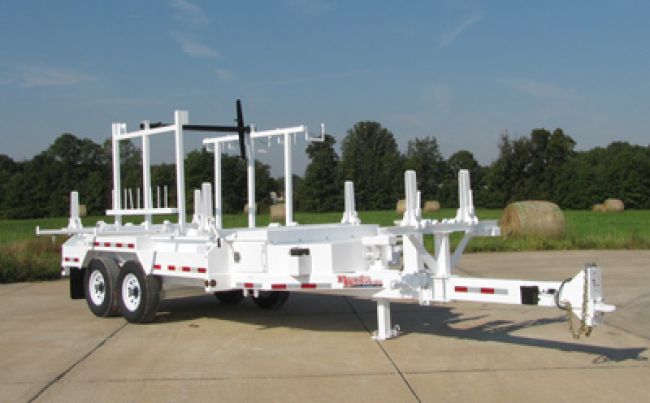
Watch Your Overhang: Spec’ing Utility Pole Trailers for Maximum Safety
“Mind your lengths and weights” could be the mantra for any utility spec’ing a new utility pole trailer. Pole lengths and weights, as well as the operating terrain and tie-down options, are some of the safety-related factors to consider when ordering a new trailer, industry experts said.
At the top of the safety spec’ing list is determining the length of the longest pole that will be transported and how much overhang is considered safe, said Mark Rapp, utility/telecom product manager with Felling Trailers (www.felling.com). The legal standards for overhang vary by state, and it’s up to the utility to know and abide by the regulations.
Additionally, fleets need to think about how mixing different pole lengths and classes on a trailer will affect performance and safety.
“A Class 1 pole is more rigid than a Class 5 pole and therefore can tolerate more overhang,” Rapp said. “[It’s] up to the end user or the pole supplier to determine how much overhang they can tolerate.”
Included in those length considerations is the necessity to spec enough space between the poles and the towing truck that the truck can make tight turns without contacting the poles at the front of the trailer, said Joe Siefkas, inside sales specialist with Brooks Brothers Trailers (www.brooksbrotherstrailers.com).
“Not taking these factors into account when choosing and specifying [utility pole trailers] forces crews to unsafely load trailers with poles that are too long,” Siefkas said.
Spec the Axle Location
The maximum payload is going to help set the axle configuration and frame design, Siefkas noted. The gross vehicle weight rating is the combined axle weight rating plus about 15% load transfer to the hitch. Subtracting the curb weight of the empty trailer provides the payload capacity.
“Not creating detailed requirements can lead to trailers being overloaded or unable to handle the rough duty expected of utility construction trailers,” Siefkas said.
Axles must be located at the rear of the trailer to balance the load between the axles and the hitch. As a general rule, the National Association of Trailer Manufacturers recommends placing approximately 60% of the load forward of the axle and 40% behind the axle to achieve proper tongue weight.
Not spec’ing the axle location can lead to an overloaded tongue and hitch, Siefkas said. Without proper axle location, an upward cantilever force will be transferred to the tongue and hitch. Improper tongue and hitch loading can cause the trailer to whip back and forth at moderate speeds.
Factor in Trailer Connections
Trailer tongues extend and retract, so it is important to factor in trailer connections and wiring systems when spec’ing, Rapp said. Plugs are the most common linkage – common enough that crews shouldn’t make mistakes, but stuff happens. The biggest safety concern is if the field crew forgets to make the connection or forgets to pull the plug when extending the tongue, Rapp explained.
“What may be worse is forgetting to plug the connection back in,” he said. “Then you’re running with no lights or brakes. If the trailer breaks away, the safety system won’t function.”
Felling’s pole trailers don’t require crew intervention when extending or retracting.
Finally, a trailer should be spec’d with pole stubs and winch binders that will tighten and secure the poles to the trailer. A pole stub and winch binder should be placed at an intermediate location between the hitch and axles, Siefkas said. Brooks Brothers offers trailers with four or more tie-down locations, with an optional removable tongue-mounted winch binder.
“Not specifying the necessary pole stub and binders leads to having a less secured load, and it can lead to excessive tongue deflection and damage,” Siefkas said.
About the Author: Jim Galligan has extensive experience covering the commercial truck transportation and utility fleet sectors.
*****
Spec’ing for Diverse Utility Poles
Wood poles are the most common type of utility poles, but there are some additional spec’ing precautions fleets should keep in mind if they are going to be hauling mixed or other types of poles, such as wood laminate, fiberglass or concrete.
For starters, padded and/or additional bolsters and tie-downs may be required, and the rear overhang may need to be reduced as well.
Unlike a wood pole that is tapered, a lot of these poles have a center of gravity either in the center or near to it.
Finally, Mark Rapp, utility/telecom product manager with Felling Trailers, recommended against using a pole trailer to haul pipe lengths unless the material being hauled will hang off the back, similar to a utility pole. If the material being hauled is required to be supported along its entire length, a utility pole trailer model is not recommended.
Source: “Utility Pole Trailers 101,” Felling Trailers

